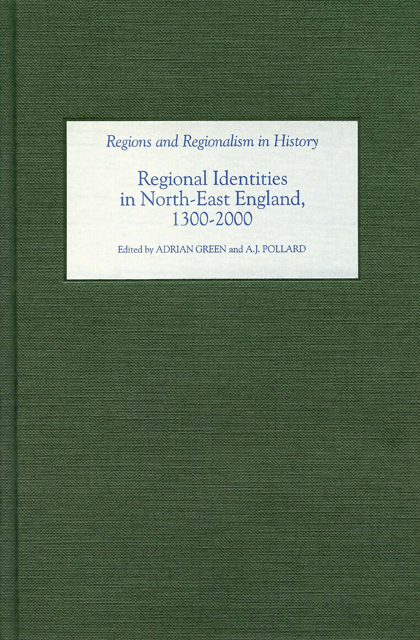Book contents
- Frontmatter
- Contents
- Foreword The AHRC Centre for North-East England History
- Dedication
- Contributors
- Preface
- Abbreviations
- Map
- Introduction Identifying Regions
- 1 North-East England in the Late Middle Ages: Rivers, Boundaries and Identities, 1296-1461
- 2 Borders and Bishopric: Regional Identities in the Pre-Modern North East, 1559-1620
- 3 Law in North-East England: Community, County and Region, 1550-1850
- 4 A Shock for Bishop Pudsey: Social Change and Regional Identity in the Diocese of Durham, 1820-1920
- 5 Business Regionalism: Defining and Owning the Industrial North East, 1850-1914
- 6 Competing Identities: Irish and Welsh Migration and the North East of England, 1851-1980
- 7 Immigrant Politics and North-East Identity, 1907-1973
- 8 Regionalism and Cultural History: The Case of North-Eastern England, 1918-1976
- Conclusion Conclusion Finding North-East England
- Index
Conclusion - Conclusion Finding North-East England
Published online by Cambridge University Press: 10 March 2023
- Frontmatter
- Contents
- Foreword The AHRC Centre for North-East England History
- Dedication
- Contributors
- Preface
- Abbreviations
- Map
- Introduction Identifying Regions
- 1 North-East England in the Late Middle Ages: Rivers, Boundaries and Identities, 1296-1461
- 2 Borders and Bishopric: Regional Identities in the Pre-Modern North East, 1559-1620
- 3 Law in North-East England: Community, County and Region, 1550-1850
- 4 A Shock for Bishop Pudsey: Social Change and Regional Identity in the Diocese of Durham, 1820-1920
- 5 Business Regionalism: Defining and Owning the Industrial North East, 1850-1914
- 6 Competing Identities: Irish and Welsh Migration and the North East of England, 1851-1980
- 7 Immigrant Politics and North-East Identity, 1907-1973
- 8 Regionalism and Cultural History: The Case of North-Eastern England, 1918-1976
- Conclusion Conclusion Finding North-East England
- Index
Summary
We set out to answer the question as to whether the North East of England can be shown to have been a coherent and self-conscious region over the centuries. In some respects this has turned out to be two questions.Was the North East a single region, and if so, did the people who lived there share a sense of regional identity? The identity of a region, as Paasi commented, is not the same as regional identity. In providing answers, we have discovered, much depends on the definition of region and conceptualisation of regional identity. Simple geographical models are inadequate.The notion that the North East as a region is, and always has been, the area between the Pennine watershed, the Tweed, the North Sea and the Tees, determined by the physical bounds, is unsustainable. While views might differ over the extent to which a sense of place is tethered culturally and socially to landscape and topography, it is undoubtedly human agency that makes a region. One of the first and most compelling conclusions to emerge from these studies is that the idea of a north-east region as conventionally conceived is a modern phenomenon. Precisely how modern is a matter of continuing debate. It may be effective advocacy to assert that this has always been a region with a unique history and culture, but it is inaccurate history.
In seeking to locate North-East England in more secure historical terms, it is worth clarifying further the geographical context by highlighting some key dynamics which have not been fully addressed in this volume. The area known today as North-East England is ultimately defined by its location in the north and east of England.The North East has always been – and continues to be – a part of a larger North. It is rarelyemphasised that it is also a part of a larger East – readily discernible in the characterisation of the region but never much a feature of articulated identities.
- Type
- Chapter
- Information
- Regional Identities in North-East England, 1300-2000 , pp. 209 - 226Publisher: Boydell & BrewerPrint publication year: 2007



